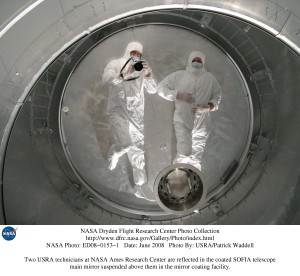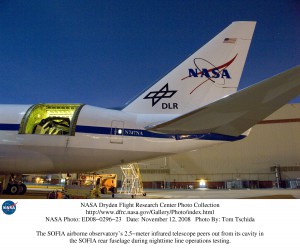
By Kerry Ellis
As early as the beginning of the seventeenth century, when Galileo used his telescope to turn Ptolemy’s geocentric theory on its ear, astronomers have continually sought better ways to look into the heavens to discern what exists in the depths of our star-studded universe.

SOFIA flies over Dryden after a ferry flight from Waco, Texas.
Photo Credit: NASA Dryden Flight Research Center
This scientific pursuit has resulted in numerous ground-based observatories and, more recently, space telescopes, but very few airborne observatories. The Stratospheric Observatory for Infrared Astronomy (SOFIA) is here to change that.
With several infrared telescopes currently in operation, including Mauna Kea Observatories in Hawaii, Kitt Peak National Observatory in Arizona, and NASA’s Spitzer Space Telescope, adding one more may seem like overkill. But SOFIA offers some advantages the other observatories do not. To understand these benefits, it helps to first understand the unique advantages infrared astronomy offers over optical, or visible light, astronomy.
Due to the expansion of the universe, objects that are furthest away from Earth have their light shifted to longer wavelengths. Viewing the infrared wavelength allows us to observe visible light from stars in distant galaxies. Many interesting objects, such as the dusty gas clouds where stars are formed or planets outside our solar system, are also too cold to emit visible light, but they glow brightly in infrared. Also, dust can obscure many things in the visible light range, which is why the Milky Way appears to have dark, blank patches between its billions of stars. Stars do exist within those voids, and infrared wavelengths pierce through the dust obscuring them, allowing an infrared telescope to see what lies beyond.
However, infrared light is absorbed by moisture in the atmosphere, which is why infrared observatories are built high upon mountains or launched into space. Ground observatories are limited to what can be seen from a fixed location and get above only a portion of the water vapor in Earth’s atmosphere, and space telescopes eventually run out of the cryogen needed to keep infrared instruments cold enough to operate. SOFIA eliminates most of these disadvantages.
Its infrared telescope is mounted in the rear fuselage of a highly modified Boeing 747SP aircraft, which will fly at about 40,000 ft. to get above 99 percent of the moisture in the atmosphere. It will be able to land each night for refueling, servicing, or even technological updates to keep the instruments cutting-edge. SOFIA’s mobility will allow it to fly anywhere in the world to observe celestial events, including occultations, or eclipses of stars. A ground-based observatory may experience a dozen of these events out of the couple hundred that occur in a year, reducing the chances for valuable new discoveries. For example, the Kuiper Airborne Observatory, SOFIA’s predecessor, discovered the atmosphere around Pluto by observing an occultation in which the light of a star behind the planet did not sharply drop off but instead slowly waned and waxed, refracting through Pluto’s atmosphere.
Reorganizing for Success
The SOFIA project began about ten years ago. After several schedule delays and cost overruns that threatened to end the project before it flew, SOFIA changed from a contractor-led project with government oversight to a government-led model with contractor support.
Part of this change included moving the program office to Dryden Flight Research Center. Dryden’s expertise includes development, testing and evaluation, and flight research, which benefit SOFIA’s current development and testing phase. For the next few years, the program challenges will be finishing the system integration and testing numerous modifications and subsystems. The most significant of these is the structural change needed to accommodate the large hole in the fuselage for the telescope. The team extensively tested the modification in a wind tunnel, working to ensure the modified aircraft flies just like the unmodified aircraft. The proof will be in the flight test.
The reorganization also aligned the various organizations involved with SOFIA according to their strengths. For example, Ames Research Center and USRA became responsible for the science associated with SOFIA, while Dryden and its supporting contractors are responsible for the integration, testing, and operation required to turn the airplane into an observatory.

Two USRA technicians at NASA Ames Research Center are reflected in the coated SOFIA telescope main mirror suspended above them in the mirror coating facility.
Photo Credit: NASA
Before the move, the German space agency Deutsche Zentrum für Luft und Raumfahrt (DLR), which is contributing funding to the project and building the telescope, helped fight to keep SOFIA from being canceled. While the move changed the main points of contact for DLR, communication has helped maintain cohesion among the team.
In addition to weekly teleconferences involving the German and NASA program offices—which take place early in the morning since Germany is nine hours ahead of the west coast—the project leaders have created independent project teams, or IPTs, to help coordination and communication efforts. For example, the telescope has an IPT comprising NASA, DLR, and contractor team members to facilitate knowledge sharing and team cohesion.
Since SOFIA’s hardware development and testing occur at Dryden, most of the DLR engineers work there. Michael Toberman, deputy project manager for SOFIA, also had the opportunity as part of his career development plan to work overseas in Germany at DLR for nearly four months and learn how the agency works. His experience has helped him better coordinate the SOFIA efforts back home.
Getting Ahead
While SOFIA is now ahead of the game on its cost and delivery schedule, its earlier delays disenchanted the science community. Lacking the support of its main audience, SOFIA again teetered on the edge of extinction.
To reinvigorate the scientists and regain their trust, the SOFIA team first listened to what the scientists wanted. They obtained feedback from the community through existing program reviews and other input. High-level NASA and National Research Council science advisory groups, such as the NASA Advisory Council, the Committee on Astronomy and Astrophysics, and the Astronomy and Astrophysics Advisory Committee, also regularly reviewed the SOFIA program. “The messages I received were (1) ‘we want the science scheduled quickly’ and (2) ‘we want a credible cost and schedule to get there,’” said Bob Meyer, SOFIA’s program manager. So the team brainstormed creative ways to get science from the first inflight observations as quickly and credibly as they could. The program philosophy changed from finishing the observatory before testing began to an approach that pursued the minimum capability required to obtain limited science observations as early as possible. “It’s a fly a little, fix a little, fly a little philosophy,” said Meyer.
Once the team established the schedule, they set about proactively communicating it and providing updates on how they were meeting it. They published regular announcements on the mission Web site and sent speakers to meetings and departmental colloquia around the world, including regular American Astronomical Society (AAS) meetings, to speak directly with the scientists. Meyer added, “We also have independent science review teams, comprising people not involved with the program, come look at SOFIA once or twice a year. They have favorable feedback, and they share their observations with their colleagues.”

The SOFIA airborne observatory’s 2.5-meter infrared telescope peers out from its cavity in the SOFIA rear fuselage during nighttime line operations testing.
Photo Credit: NASA Dryden Flight Research Center
Another concern for SOFIA was the age of its science vision, which was cutting-edge when the program began in the nineties. But a decade later, the team was worried about the science becoming stale, in large part because of new discoveries from the Hubble Space Telescope and new infrared observatories such as Spitzer. “We conducted workshops in conjunction with the biannual AAS meetings, looking at what science was current and where SOFIA could add the most value,” said Meyer. “With the workshops and people seeing how close we are to flying with a science instrument, we’ve really turned the science community around.”
The SOFIA team also announced to the world that the observatory had successfully flown from Waco, Texas, to Dryden during an event to unveil the airplane. Originally christened by Charles Lindberg’s wife when the plane went into service for Pan Am, SOFIA still bears its original moniker of “Clipper Lindberg” on its side. The team invited Eric Lindberg, Charles’s grandson, to rechristen the Boeing 747 for science. “That event marked a turning point; it showed that SOFIA had flown and was real,” said Meyer.
Moving Forward
SOFIA has conquered many hurdles, and the team is doing everything within its power to carry out the mission’s first science observation flight on schedule in 2009. Part of their preparation includes testing for and eliminating any acoustic resonance that may occur while flying with the telescope observation door open. “It’s the same thing that happens when you blow air over the top of an empty bottle,” explained Meyer. “Acoustic resonance would vibrate the structure and could put the mission at risk.”
Acoustic resonance brought a Department of Defense (DoD) project to a standstill, so the SOFIA team spoke with the DoD to learn about its approach to flight tests. “We’re doing more extensive wind tunnel and analytical testing than they did, and we don’t believe we’ll have the same issue,” said Meyer. “It’s a risk we carry until we fly with the door open for the first time, which should be in about three months.”
With continued communication among the team and with the science community, SOFIA is sure to take off and bring to light new discoveries hidden behind the dust of space, such as how planets and stars form, how material is processed within and cycled through the spaces between stars, the composition and structure of planetary atmospheres, and the role of ultraluminous infrared galaxies in the formation of the early universe.








